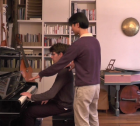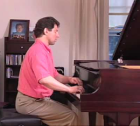Benefits and Research
The Alexander Technique attracts individuals wanting to improve mobility, ease postural discomfort, reduce chronic pain, and manage stress, while others seek lessons to advance their skills in the performing arts and athletic endeavours. Browse the menu lists below to learn more about how Alexander Technique can benefit you.
Use of resources
Please note that the content within the Research & Resources and Videos sections is provided only for general information purposes.
Use of Resources
Please note that the content within the Research & Resources is provided only for general information purposes. Many of the resources, such as books, are not free. Links to other websites or platforms are provided for viewers’ convenience, but ATC does not control or monitor them and accordingly cannot endorse their information or guarantee its accuracy and relevance. The use of content or links to third-party websites is at the viewers’ own risk. Viewers should contact an ATC-certified Alexander Technique teacher with any questions about the application of Alexander Technique to their specific issues.
Piano
- Benefits
- Resources
- Videos
- Testimonials
Pianists enjoy the freedom that comes with applying Alexander Technique to their playing. Instead of creating tension by pulling the arms into the torso as pianists often do when playing staccato, for example, they learn to direct the energy of the arm all the way to the fingertips and into the depth of the keys. Instead of struggling through difficult passages as they trap tension in the shoulders, chest and arms, they find technical challenges, such as large leaps across the keyboard or successive octaves melt away as muscular tension is removed from the shoulders, upper back, and arms.
In contrast, playing the piano can cause troubling physical issues for pianists who have not had the advantage of Alexander Technique lessons. They typically hold too much tension in their hands, arms, shoulders, neck, and back. They hunch over the keys and tense their shoulders to gain volume but often the resulting tone becomes more harsh. In an expressive response to the beauty of the music, pianists lift their shoulders and arch and tighten their lower back, neither of which assists them to play better. Pianists may also ignore what they are doing with their legs, incorrectly believing that they are of little relevance to their playing.
Pianists often unconsciously want to keep their torso between their arms; they move their torso as they move their arms along the keyboard, forcing them to lift one side of their hips off the bench while holding the opposite hip, leg and lower back with unwarranted tension to keep their balance. This can lead to a see-saw movement of their hips as the arms move up and down the keyboard. It often does not occur to pianists that they can freely allow the arms to cross or extend away from the torso or turn their torso if they have any issues with reaching the outer-most notes.
Alexander Technique shows pianists how to achieve power generated from the expansion of the entire torso and unity of the body. They gain greater warmth, fullness, and control of their tone when they stop bad habits that interfere with the flow of music.
Pianists come to appreciate that they do not need to impose a specific form to the hands and fingers and that having a high wrist and very curved fingers can increase tension in the hand, wrist and forearm, taking away, to some degree, the control of the sound. Instead, they discover a lengthening of the fingers and nuance and control with the palm of the hand.
When you stop doing the wrong thing, the right thing does itself.
– F.M. Alexander
General Articles
What Every Pianist Needs to Know About the Body
“When I began to learn the Alexander Technique, I was looking for something that would help me to understand how the body works, particularly in relation to playing and teaching piano. As a pianist I have learned to play in a more balanced and efficient way, tackling repertoire that previously would have been too challenging for me. As a teacher, the exploration of habit, and the process of changing, has given me many more ‘doors in’ to help students with the physical, musical and emotional demands of learning to play. Further, through working on a piano teaching research project in collaboration with my AT teacher, my observational skills have been enhanced, as has my repertoire of Alexander inspired practices that support my teaching.
What I didn’t expect when I began, was the transformative effect of AT on my thinking, and approach to solving problems. There is a pause and a saying no to habit that applies to many situations in life, and I am increasingly able to take it.
And then there are what I consider the small ‘perks’…my shoulders no longer need massages to work out the tension from teaching, my low back no longer troubles me, and my left knee no longer goes out of joint when I crouch. These changes happened quite quickly and have stayed stable for many years now.
Alexander Technique has many benefits for a person to explore. It has thoroughly
enriched my life.”





